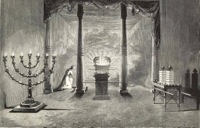Difference between revisions of "Holy of holies"
m (Text replacement - "http://" to "https://") |
|||
| Line 3: | Line 3: | ||
==Origin== | ==Origin== | ||
[[Translation]] of Late Latin ''sanctum sanctorum'', translation of [[Hebrew]] ''qōdhesh haq-qŏdhāshīm'' | [[Translation]] of Late Latin ''sanctum sanctorum'', translation of [[Hebrew]] ''qōdhesh haq-qŏdhāshīm'' | ||
| − | *[ | + | *[https://en.wikipedia.org/wiki/17th_century 1641] |
The construction "Holy of Holies" is a [[literal]] translation of a Hebrew [[idiom]] which is intended to express a superlative. Examples of similar constructions are "servant of servants" (Gen 9:25), "Sabbath of sabbaths" (Ex 31:15), "God of gods" (Deut 10:17), "Vanity of vanities" (Eccl 1:2), "Song of songs" (Song of Songs 1:1), "king of kings" (Ezra 7:12), etc. | The construction "Holy of Holies" is a [[literal]] translation of a Hebrew [[idiom]] which is intended to express a superlative. Examples of similar constructions are "servant of servants" (Gen 9:25), "Sabbath of sabbaths" (Ex 31:15), "God of gods" (Deut 10:17), "Vanity of vanities" (Eccl 1:2), "Song of songs" (Song of Songs 1:1), "king of kings" (Ezra 7:12), etc. | ||
| − | In the [ | + | In the [https://en.wikipedia.org/wiki/Authorized_King_James_Version Authorized King James Version], "Holy of Holies" is always translated as "Most Holy Place". This is in keeping with the [[intention]] of the Hebrew idiom to [[express]] the utmost degree of [[holiness]]. The King James Version of the Bible has been in [[existence]] for over four hundred years. For most of that time, it was a primary [[reference]] in much of the [[English]] speaking world for [[information]] about Judaism. Thus, the name "Most Holy Place" was used to refer to the "Holy of Holies" in many English documents. |
| − | A related term is the [ | + | A related term is the [https://en.wikipedia.org/wiki/Debir debir] (דְּבִיר) transliterated in the [https://en.wikipedia.org/wiki/Septuagint Septuagint] as ''dabir'' (δαβιρ), which either means the back (i.e. western) part of the Sanctuary, or derives from the verb stem D-V-R, "to speak", justifying the translation in the Latin Vulgate as ''oraculum'', from which the traditional English translation "[[oracle]]" (KJV, 1611) comes. |
==Definition== | ==Definition== | ||
| − | *1: the innermost and most [[sacred]] chamber of the Jewish [ | + | *1: the innermost and most [[sacred]] chamber of the Jewish [https://en.wikipedia.org/wiki/Tabernacle tabernacle] and [https://en.wikipedia.org/wiki/Temple_in_Jerusalem temple] |
==Description== | ==Description== | ||
| − | The '''Holy of Holies''' (Tiberian Hebrew: קֹדֶשׁ הַקֳּדָשִׁים ''Qṓḏeš HaqQŏḏāšîm'') is a term in the [ | + | The '''Holy of Holies''' (Tiberian Hebrew: קֹדֶשׁ הַקֳּדָשִׁים ''Qṓḏeš HaqQŏḏāšîm'') is a term in the [https://en.wikipedia.org/wiki/Hebrew_Bible Hebrew Bible] which refers to the inner sanctuary of the Tabernacle and later the Temple in Jerusalem where the [https://en.wikipedia.org/wiki/Ark_of_the_Covenant Ark of the Covenant] was kept during the [https://en.wikipedia.org/wiki/First_Temple First Temple], which could be entered only by the [https://en.wikipedia.org/wiki/High_Priest_(Judaism) High Priest] on [https://en.wikipedia.org/wiki/Yom_Kippur Yom Kippur]. The Ark of the Covenant is said to have contained the [[Ten Commandments]], which were given by God to [https://en.wikipedia.org/wiki/Moses Moses] on Mount Sinai.[https://en.wikipedia.org/wiki/Holy_of_holies] |
[[Category: Religion]] | [[Category: Religion]] | ||
[[Category: History]] | [[Category: History]] | ||
Latest revision as of 00:16, 13 December 2020
Origin
Translation of Late Latin sanctum sanctorum, translation of Hebrew qōdhesh haq-qŏdhāshīm
The construction "Holy of Holies" is a literal translation of a Hebrew idiom which is intended to express a superlative. Examples of similar constructions are "servant of servants" (Gen 9:25), "Sabbath of sabbaths" (Ex 31:15), "God of gods" (Deut 10:17), "Vanity of vanities" (Eccl 1:2), "Song of songs" (Song of Songs 1:1), "king of kings" (Ezra 7:12), etc.
In the Authorized King James Version, "Holy of Holies" is always translated as "Most Holy Place". This is in keeping with the intention of the Hebrew idiom to express the utmost degree of holiness. The King James Version of the Bible has been in existence for over four hundred years. For most of that time, it was a primary reference in much of the English speaking world for information about Judaism. Thus, the name "Most Holy Place" was used to refer to the "Holy of Holies" in many English documents.
A related term is the debir (דְּבִיר) transliterated in the Septuagint as dabir (δαβιρ), which either means the back (i.e. western) part of the Sanctuary, or derives from the verb stem D-V-R, "to speak", justifying the translation in the Latin Vulgate as oraculum, from which the traditional English translation "oracle" (KJV, 1611) comes.
Definition
- 1: the innermost and most sacred chamber of the Jewish tabernacle and temple
Description
The Holy of Holies (Tiberian Hebrew: קֹדֶשׁ הַקֳּדָשִׁים Qṓḏeš HaqQŏḏāšîm) is a term in the Hebrew Bible which refers to the inner sanctuary of the Tabernacle and later the Temple in Jerusalem where the Ark of the Covenant was kept during the First Temple, which could be entered only by the High Priest on Yom Kippur. The Ark of the Covenant is said to have contained the Ten Commandments, which were given by God to Moses on Mount Sinai.[1]
